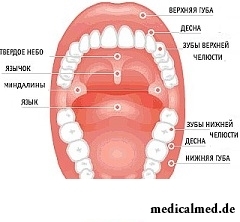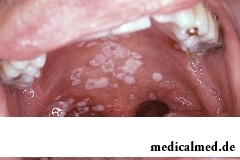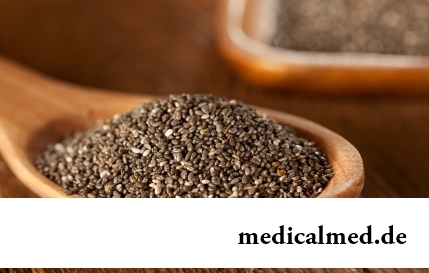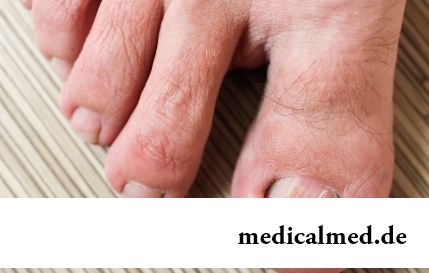





Oral cavity
The digestive tract begins an oral cavity.  This not only its anatomic beginning – already in an oral cavity begins digestion of food. Besides, the oral cavity has a number of the additional functions which are not connected with digestion.
This not only its anatomic beginning – already in an oral cavity begins digestion of food. Besides, the oral cavity has a number of the additional functions which are not connected with digestion.
Oral cavity structure
Its borders are an oral crack in front and a throat behind. The oral crack is in turn limited to upper and lower lips.
Conditionally oral cavity is divided into two departments. The front department – an entrance of the mouth – is limited to lips and cheeks in front both teeth and jaws behind. The threshold has the horseshoe form. The back department – actually an oral cavity – in front of and from sides is limited to teeth and jaws, behind – an isthmus of the fauces which is the beginning of a throat. From above border of an oral cavity is firm and partially soft palate, from below – a muscular framework which is called a bottom of an oral cavity.
The soft palate comes to an end with a uvula which takes part in formation of a voice, and in a quiet state hangs down down. Mucous oral cavities, moving down from a soft palate, forms a uvula palatal handles on each side – between which accumulations of an adenoid tissue – palatine tonsils are located.
In an oral cavity the central place is taken by language. From it to a bottom of an oral cavity there is a bridle – a fold of a mucous oral cavity. On each side from a bridle it is possible to notice outlet openings of channels of sialadens.
Functions of an oral cavity
In a mouth digestive process begins – food is crushed by teeth, humidified with saliva with formation of a food lump, warmed or cooled up to the necessary temperature.
Saliva performs a number of important functions:
- Zymolysis of carbohydrates;
- Clarification of an oral cavity from leftovers, neutralization of the acids which are formed after meal and protection of teeth against caries;
- Specific and nonspecific host defense;
- Contains biologically active agents regulating a metabolism;
- Participates in formation of sounds.
The oral cavity takes part in breath, formation of the speech and an articulation.
Palatine tonsils play an important role in a host defense of an organism from infections. They are a part of a so-called "limfoglotochny ring" which is protective "gate" on border of respiratory tracts.
At a mouth there are microorganisms all the time – constant and non-constant. The quantity them regularly changes, and in many respects depends on hygiene of an oral cavity. Constant microflora is presented by generally anaerobic bacteria and fungi which can live without air. Contacting receptors on an epithelium surface, they play a role of a biological barrier as do not allow to breed to pathogenic microbes. Besides, own microflora promotes self-cleaning of an oral cavity, and all the time stimulates local immunity. Change of structure of microflora can lead to developing of diseases of an oral cavity.
Ways of a research of an oral cavity
Detection of pathology begins with inquiry of the person about his complaints. Most often at oral cavity diseases people complain of pain and disturbances at reception of food, a conversation, swallowing. For example, when the person shows complaints to constant feeling of dryness in a mouth, it can be a sign of depression of function of sialadens. Unpleasant began to smell from a mouth – a sign of a periodontal disease, caries or an ulitis. Defects of diction can be promoted by incorrectly picked up denture, a sky crevice.
During survey estimate a relief of a mucous membrane, its color, existence of erosion and ulcers, prints of teeth in language, health of teeth.
To reveal the diseases which are followed by excessive keratinization mucous it irradiate with luminescent beams of a lamp of Wood. Sometimes bacteriological, cytologic, immunological inspection or statement аллергопроб is required. Clinical blood test at diseases of an oral cavity is minimum necessary diagnostic testing.
Oral cavity diseases
The oral cavity is affected by the most various diseases. Inborn malformations form vnutriutrobno, and are generally presented:
- Crevice of an upper lip (one - or bilateral);
- Crevice of an under lip;
- Crevice of a hard palate;
- Lack of lips (achylia);
- Accretion of lips on each side (sinkheyliya).
Treatment of an oral cavity at such defects surgical. The thickened and shortened bridle of language is carried to stigmata of a dizembriogenez.
The group of diseases of a mucous oral cavity is very extensive - it is both infectious, and allergic, and tumoral processes. Inflammatory processes on a mucous membrane of a mouth are called stomatitis. Health of all organism is reflected in a condition of a mucous oral cavity.
Caries – the damage to tissues of tooth caused by disturbance of acidity of an oral cavity and activation of its microorganisms. In its emergence disturbances of hygiene of an oral cavity and the hereditary factors defining stability of tissues of tooth in an aggressive environment play a role. Treatment of an oral cavity at caries and other diseases of teeth – the stomatologist's task.
When as a result of decrease in local or general immunity in a mouth sort fungi Candida which are always present there actively breed, oral cavity candidiasis develops. Pathological process in an oral cavity most often occurs at newborn, elderly people and HIV-positive people. It is shown by unpleasant painful feelings, burning sensation, and on the struck surface it is possible to see a white curdled plaque under which after removal of a plaque the bright red erosion is bared. In most cases candidiasis of an oral cavity is effectively treated by local antifungal means in the form of solutions or sprays. Purpose of antifungal drugs inside in capsules and tablets is required only at the expressed immunodeficiency.
Injuries and mechanical damages of an oral cavity quickly heal thanks to high regenerative ability of a mucous membrane.
If to smile all twice a day – it is possible to lower blood pressure and to reduce risk of developing of heart attacks and strokes.

Small appetite at the child – the complaint which pediatricians should hear practically from each mother. Most often it is carried to разр...
Section: Articles about health
The medicine promptly develops, and the fact that else quite recently it seemed by miracle can now. We are not surprised any more to the fact that people with artificial joints and extremities can play sports, organ transplantation became a routine, and the latest cancer medicine п...
Section: Articles about health
Impossibility to conceive the child – a trouble of many Russian families. During quite long time was considered that main "culprits" of troubles such are women. Modern physicians claim that the situation is different: about a half of failures in attempts of reproduction are connected with male infertility....
Section: Articles about health
Cold – a state known to everyone which is followed by cold, cough, high temperature, a pharyngalgia. Often перво...
Section: Articles about health
Statistically, pathologies of a thyroid gland in the world more than 500 million people have. Failures in work of this body lead to heavy disbolism, development of heart diseases, vessels, a reproductive and nervous system. In hard cases excessive...
Section: Articles about health
Cystitis, or inflammation of a mucous membrane of a bladder, this very widespread disease which, owing to some features of a structure of bodies of urinogenital system, women have approximately four times more often than men. Women aged from 20 up to 45 years enter into the main risk group. Cystitis is an illness of a bacterial origin. It can have an acute or chronic current. The second option is dangerous not only a frequent recurrence, серьезн...
Section: Articles about health
The popular expression "run from a heart attack" became the motto of the people supporting active lifestyle. Moreover, run became peculiar...
Section: Articles about health
Dietary supplements (dietary supplements) for the last decades were so thoroughly included into our life that, apparently, it is already impossible to find the person who at least once did not try them. At the same time, most of our compatriots have a vague idea about...
Section: Articles about health
Shops of household appliances offer us the huge choice of various devices for the house. Whether there are among this abundance devices which not only facilitate house work, but also help to keep health of the person? Of course, and we will tell about them today....
Section: Articles about health
So, you resolved to lose weight. And now you try to understand what to begin with: from exercise stresses or a diet? And how to make, h...
Section: Slideshow
The chia plant, or the Spanish sage, is from South America. The indigenous people of the continent since ancient times used its seeds in food: small, but very nutritious kernels, in a form the reminding fasolina. Indians knew about useful properties of seeds of a chia, and applied...
Section: Articles about health
The word "onikhokriptoz" is unfamiliar to most of people, meanwhile quite so physicians call very widespread problem: the growing of edge of a nail into surrounding fabrics causing inflammatory process. Usually the illness affects thumbs of legs, and is followed by reddening, hypostasis, and in the started cases – release of pus. Patients complain of the pain amplifying when walking, problems with the choice of footwear....
Section: Articles about health
History of mankind contains several tens of epidemics whose emergence was compared by eyewitnesses and historians to doomsday. With...
Section: Articles about health
Life of the modern child is extremely active and difficult. Information strain which is experienced by the school student and did not dream pupils of last times. Careful parents, wishing well to the children, will organize a set of additional classes in circles, sports...
Section: Articles about health
Scientists always aimed to offer fundamental explanations for medical problems. Their theories formed the basis of modern methods of treatment of the hardest pathologies and helped to save a set of lives. However stories are known also such theoretical constructions, following to which brought to mankind of a trouble and torture, ruined destinies and health of many people....
Section: Articles about health
The way of life of people promptly changes from year to year: if about ten years ago the personal computer was not in each family...
Section: Articles about health
Nightmares belong to the most unpleasant frustration. Statistically, they happen at 4% of adults, and almost at 70% of children and teenagers. During a nightmare of people dreams himself in extremely difficult, life-threatening situation. It wakens suddenly, in...
Section: Articles about health
The endocrine system carries out extremely important role in a human body, practically all processes of life activity are regulated by it. Closed glands (hemadens) produce special biologically active agents – hormones which then get to a blood channel and are transferred to bodies addressees, or as they are called still, to target organs. Frustration of this mechanism are fraught with development of serious chronic pathologies....
Section: Articles about health
An eye of the person daily experiences considerable strain. The problem of preservation of sight is for many years directly connected with a question снабж...
Section: Articles about health
According to World Health Organization, every third inhabitant of Earth has excess weight, and every tenth has obesity. The reason of this phenomenon, according to specialists, roots in one not very comforting fact: most of people consume much...
Section: Articles about health
Dark circles (bruises) under eyes – a shortcoming with most of which often fight against the help of cosmetics (proofreaders, saloon procedures and so forth), eliminating only its visibility. However, according to doctors, skin around eyes – the indicator of many disturbances in an organism. To reveal them at early stages, without having disguised bruise, and having addressed its reasons – a task of each person who is regularly finding under with own eyes dark stains. Early detection and elimination of the disease lying in wasps...
Section: Articles about health
The name of this disease precisely reflects the problem reason: it consists in the bra fastener pressure upon a certain zone...
Section: Articles about health
What is in our understanding weeds? It plants which are considered to be suitable only for compost pits and feeding of animals. Meanwhile, among the weeds growing literally under legs it is possible to find the mass of the officinal herbs possessing invaluable Paul...
Section: Articles about health
Osteoporosis this general disease which main sign is decrease in density of a bone tissue. On distribution width it takes the fourth place among noninfectious diseases. The illness develops at mature age more often: in our country about a third of women and a quarter of men suffers from it 50 years are more senior....
Section: Articles about health
The drugs stopping or oppressing life activity of pathogenic microorganisms are widely applied in clinical practice with 4...
Section: Articles about health
Doctors claim that the people not so familiar with a dorsodynia occur among adult Russians very seldom. At the same time the vast majority of the patients who are periodically testing this indisposition do not hurry to ask for medical care at all. With one St...
Section: Articles about health
80% of women at least once to lives complained of discomfortable feelings to breasts, consolidations and nagrubaniye. These are mastopathy symptoms. The mastopathy is characterized by change of a ratio between ferruterous and connective tissue tissues of mammary glands. It can lead to formation of cysts (a cystous mastopathy), gland consolidation (a fibrous mastopathy), or a combination of these processes (a fibrous and cystous mastopathy)....
Section: Articles about health
